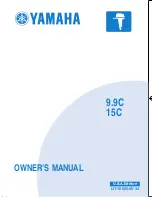
VIA 693 Socket 370 AT Mainboard
AWARD BIOS SETUP
4-19
Primary/Secondary Master/Slave UDMA:
(Default setting: “Auto” )
Ultra DMA/33/66 implementation is possible only if your IDE hard drive supports it
and the operating environment includes a DMA driver (Windows 95 OSR2 or a
third-party IDE bus master driver). If your hard drive and your system software both
support Ultra DMA/33/66, select Auto to enable BIOS support.
Init Display First:
( Default setting : “PCI Slot” )
When you have both the AGP and PCI VGA card installed in the system, you can
use this field to decide the display priority.
AGP Slot:
the display will be active on the AGP adapter.
PCI Slot:
The display will be active on the PCI VGA adapter
KBC input clock:
( Default setting : “PCI Slot” )
This field allows to you select the clock frequency of the onchip keyboard
controller.
Onboard FDD Controller:
( Default setting : “Enabled” )
This should be enabled if your system has a floppy disk drive (FDD) installed on the
system board and you wish to use it. Even when so equipped, if you add a higher
performance controller, you will need to disable this feature.
Onboard Serial Port 1/Port 2:
( Default setting : “3F8, IRQ4/ 2F8, IRQ3” )
This item allows you to determine access onboard serial port 1/port 2 controller with
which I/O address.
The Choice: 3F8/IRQ4, 2F8/IRQ3, 3E8/IRQ4, 2F8/IRQ3, Disabled, Auto.
UR2 Mode Select:
( Default setting : “Standard” )
This item allows you to determine which Infra Red (IR) function of onboard I/O chip.
The Choice: Normal, ASKIR, HPSIR
Onboard Parallel Port:
( Default setting : “378/IRQ7” )
Select a logical LPT port name and matching address for the physical parallel port.
The choice: 378H/IRQ7, 278H/IRQ5, 3BCH/IRQ7, Disabled.
Parallel Port Mode:
( Default setting : “SPP” )
Select an operating mode for the onboard parallel port. Select Compatible or Extended
unless you are certain both your hardware and software support EPP or ECP mode.
The choice:
SPP, ECP+EPP1.7, EPP1.7+SPP, EPP1.9+SPP, ECP, ECP+EPP1.9, and




































